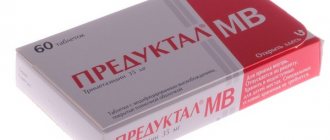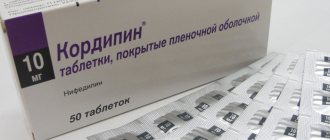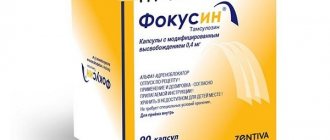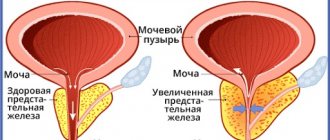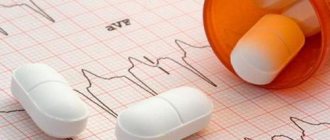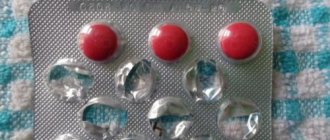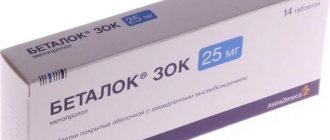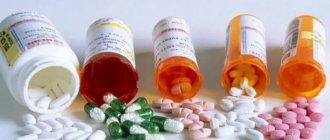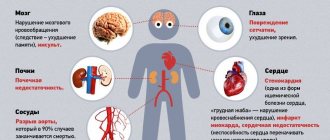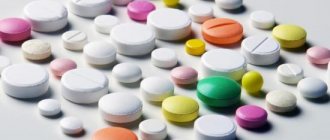Gliclazide tablets
An oral hypoglycemic drug, which is a second-generation sulfonylurea derivative, has a wide spectrum of therapeutic pharmacological action. Gliclazide is available in the form of 80 mg or 30 and 60 mg modified-release tablets. The drug has proven effectiveness, so it is often prescribed to normalize blood glucose levels.
Compound
Gliclazide 30 mg tablets have a round, flat-cylindrical shape, a chamfer, and the color is white or almost white (yellow or grayish tint). A dosage of 60 mg has a risk. The active substance is gliclazide. Composition of the drug:
| Active substance | Excipient |
| Gliclazide-30 or 60 mg | colloidal silicon dioxide |
| hydroxypropyl methylcellulose | |
| sodium stearyl fumarate | |
| talc | |
| lactose monohydrate |
Pharmacodynamics and pharmacokinetics
The drug stimulates the secretion of insulin by the pancreas (β-cells) and improves its physiological profile. The effectiveness of the drug is enhanced by the ability to increase the susceptibility of peripheral tissues to the component, reduce the period of time between food intake and the onset of secretion of the substance. As a result of taking the drug, the peak of hyperglycemia after meals is reduced in patients, and carbohydrate metabolism is normalized.
The drug reduces platelet adhesion, which reduces the risk of thrombosis and mural thrombus. Fibrinolytic vascular activity increases and vascular permeability is normalized. Gliclazide is able to lower cholesterol and free radicals, preventing the occurrence of atherosclerosis. An important property is the ability of the drug to reduce the susceptibility of blood vessels to adrenaline and resist platelet aggregation.
The drug is quickly absorbed in the gastrointestinal tract, after which the levels in the blood plasma begin to gradually increase, reaching maximum levels 7-12 hours after administration. The binding of Gliclazide to plasma proteins is 95%. The presence of food does not affect the absorption process of the drug. Metabolism of the drug occurs in the liver. The half-life is approximately 12 hours. The drug is eliminated through the kidneys in the form of metabolites.
Indications for use
The drug Gliclazide is widely used for type 2 diabetes mellitus and hyperglycemia. The reception is especially relevant in case of low effectiveness of diet therapy, methods for reducing body mass index and special physical exercises. Gliclazide is effective in preventing complications of type 2 diabetes mellitus: the development of microvascular pathologies (stroke, myocardial infarction) and microcirculation disorders (retinopathy, nephropathy).
Release form and composition
The dosage form of the drug is tablets containing:
- 80 mg gliclazide;
- Auxiliary components: sodium starch glycolate, lactose, calcium stearate, microcrystalline cellulose, colloidal silicon dioxide, hydroxypropylcellulose.
Gliclazide tablets are sold in 60 pcs. per package (10 pcs. in one blister) and 120 pcs. in plastic jars.
The drug is also available in the form of modified-release tablets Gliclazide MB, containing:
- 30 mg gliclazide;
- Additional components: hypromellose, calcium stearate, colloidal silicon dioxide, lactose monohydrate, talc.
These tablets are sold in packs of 10. in blister packs (1, 2, 3 or 6 pieces per package), as well as in polymer jars of 10 or 20 tablets.
Instructions for use of Gliclazide
The decision on the dosage size to take for hyperglycemia is prescribed based on a set of parameters: age, severity of diabetes and blood sugar levels before meals and two hours after meals. The initial recommended dose is 40 mg with food. This dosage is recommended for all patients, including the elderly. The initial daily dose is 80 mg. Further, depending on the parameters, on average, 160 mg per day. Dosage adjustment is carried out taking into account a minimum two-week period.
The maximum permissible dosage is 320 mg. If you skip a dose, you do not need to increase the dose the next day. The dosage for elderly patients and patients with renal failure is no different. Taking the drug should be accompanied by monitoring blood glucose in order to prevent hypoglycemia (increased glucose concentration).
- Zucchini in the oven - recipes with photos
- How to pump up your pectoral muscles at home
- Sex hormones LH and FSH
Gliclazide MB 30 mg
The dose volume of modified release (MR) gliclazide can range from 30 to 120 mg. Taken in the morning with food. If you miss taking a drug for hyperglycemia, compensation by increasing the dose the next day is prohibited. The decision on dosage is made individually. The initial dose is 30 mg. If the result is insufficient, the dose is gradually increased (once a month) to 60, 90 and 120 mg. Gliclazide MB can be combined with insulin. Let’s assume a comparable transition from taking regular Gliclazide 80 to Gliclazide MB 30 mg after a sugar load.
Indications
According to the instructions for Gliclazide MB, this is a hypoglycemic medication prescribed for patients with type II diabetes mellitus in moderate condition. The drug is used as a prophylactic agent for microcirculation disorders and as part of complex treatment with the simultaneous use of other medications.
A long-acting medication can only be prescribed to patients whose daily routine always includes a full breakfast, lunch and dinner. With type 2 diabetes, it is especially important to ensure optimal carbohydrate intake during meals. Snacks are also taken into account. Irregular meals, insufficient portions, and a menu with a minimum amount of carbohydrates can aggravate the patient’s condition and reduce glucose levels to critical levels.
Hypoglycemia also threatens patients who engage in excessively high and prolonged physical activity, as well as those who drink alcoholic beverages. Uncontrolled and simultaneous use of several medications that lower blood sugar is undesirable.
As a rule, treatment with gliclazide-containing drugs is resorted to when diet therapy is not effective enough, and physical activity does not produce tangible results, as well as in the case of a sharp decrease in the patient’s weight.
Instructions for use of "Gliclazide MB" 60 mg or 30 mg allow its use by patients with mild or moderate phase of renal failure. In this situation, the drug is prescribed in normal dosages.
Drug interactions
When combining Gliclazide with other drugs, you must be careful. To minimize risks, the following factors must be taken into account:
- the drug enhances the effect of anticoagulants, Warfarin;
- Miconazole, Phenylbutazone, ethanol increase the effect of the drug, increasing the risk of hypoglycemia and coma;
- other hypoglycemic drugs, beta-blockers, Fluconazole, Captopril, Cimetidine, sulfonamides, non-steroidal anti-inflammatory drugs increase hypoglycemia;
- Danazol increases the diabetogenic effect, Chlorpromazine reduces insulin secretion, glucocorticosteroids, Salbutamol, Ritodrine increase blood glucose, the hypoglycemic effect of Gliclazide.
Side effects
When using the medication, patients may experience side effects. The following are common:
- hypoglycemia, characterized by headache, increased fatigue, weakness and hunger;
- cardiopalmus;
- arrhythmia, increased blood pressure, drowsiness or insomnia;
- depression, loss of vision, tremor;
- paresis, dizziness, delirium, convulsions;
- bradycardia, fainting, coma, nausea;
- jaundice;
- inhibition of bone marrow hematopoiesis, allergic reactions;
- erythema;
- anemia, vasculitis, liver failure.
Overdose
Signs of a drug overdose include hypoglycemia, loss of consciousness, and coma. If the patient does not faint, he should be given some sugar. If coma or convulsions occur, it is necessary to call an ambulance and immediately hospitalize the patient. For treatment, 50 ml of a 40% dextrose or glucose solution is administered intravenously. After recovery, the patient is given food rich in simple and easily digestible carbohydrates, and the condition is monitored for two days. Dialysis in case of overdose does not give the desired effect because Gliclazide binds to plasma proteins.
Contraindications
If there is hypersensitivity to one of the components of the drug, it is not prescribed. Other contraindications for the medication include:
- type 1 diabetes mellitus;
- hypersensitivity to sulfonylurea derivatives or sulfonamides;
- diabetic coma, ketoacidosis, precoma;
- severe liver or kidney failure;
- simultaneous use of miconazole;
- pregnancy, lactation;
- age under 18 years;
- diabetic nephropathy;
- combination with Phenylbutazone or Danazol.
Contraindications and special conditions of use
The instructions for Gliclazide MB 60 and 30 mg warn of a number of contraindications. Among them there are those that can seriously distort the picture of the disease and cause significant harm to health. It is not recommended to prescribe the drug:
- with diagnosed type I diabetes mellitus;
- in diabetic coma;
- in case of complications due to lack of insulin in the body (ketoacidosis);
- when pathologies of the liver and kidneys are detected;
- in case of established hypersensitivity to sulfonyl-containing substances;
- persons under 18 years of age;
- if treatment is carried out with Miconazole and other imidazole drugs.
It is recommended to use the drug with extreme caution when treating elderly patients, patients who do not follow a proper diet, have severe ischemia or atherosclerosis, and while taking glucocorticosteroids for a long period of time.
The same recommendations exist for patients with thyroid hormone deficiency (hypothyroidism), impaired hormone production (hypopituitarism) and weak adrenal glands.
Doctors do not recommend the drug for use by expectant mothers and nursing women. If during lactation it is necessary to treat with this medication, the child is transferred to artificial feeding.
A person taking Gliclazide MB should be careful when driving a car or other vehicle, or when engaging in any activity that requires concentration, concentration, and reaction time. This especially applies to the initial period of treatment.
Analogs
There are several analogues of Gliclazide on the domestic pharmacological market. Some of them have an identical active substance, the other part allows to achieve a similar therapeutic effect. The following drugs are analogues of the drug:
- Gliclazide Canon;
- Glidia MV;
- Gluconorm;
- Glyclada;
- Glioral;
- Glyuketam;
- Diabetes;
- Diabrezide;
- Diaglyzide.
Gliclazide price
The cost of the drug differs depending on the manufacturer, the number of tablets in the package and the concentration of the active substance. Approximate prices for medicine:
| Tablet type | Manufacturer | Price, in rubles |
| Concentration 30 mg 30 pcs. | Canonpharma | 89 |
| 30 milligrams 60 pcs. | Canonpharma | 130 |
| 60 mg 30 pcs. | Canonpharma | 151 |
| Gliclazide MB 30 mg 60 pcs. | Ozone | 144 |
| 60 milligrams 30 pcs. | Pharmstandard | 174 |
| 30 milligrams 60 pcs. | Pharmstandard | 144 |
"Diabeton MV"
The drug "Diabeton" with a modified release of the active substance belongs to the group of 2nd generation sulfonylurea derivatives. A distinctive feature is the presence of a heterocyclic N-containing ring, which has an endocyclic bond. Experts note that when taking the medicine for 2 years, resistance does not develop.
The drug is intended exclusively for the treatment of adult patients, like the original drug Gliclazide. The price of the French medicine is 320-370 rubles per package (30 pieces).
The maximum concentration of gliclazide in the blood is observed 6-12 hours after taking the tablet. This allows you to reduce the number of medications taken per day. Doctors usually recommend taking 1-2 tablets per day. Specialists and patients leave extremely positive reviews about treatment with this drug.
Patients should be aware that the medication contains lactose. Therefore, it is not recommended to take it if you have congenital intolerance to this substance or galactosemia.
According to reviews, “Diabeton MV” is considered one of the most effective drugs from the category of sulfonylurea derivatives. A significant advantage is the rare occurrence of side effects while taking the medication. Only a specialist can determine the dosage and treatment regimen for the drug. The patient must first undergo examination. It is highly undesirable to take medications on your own to lower glucose levels.
